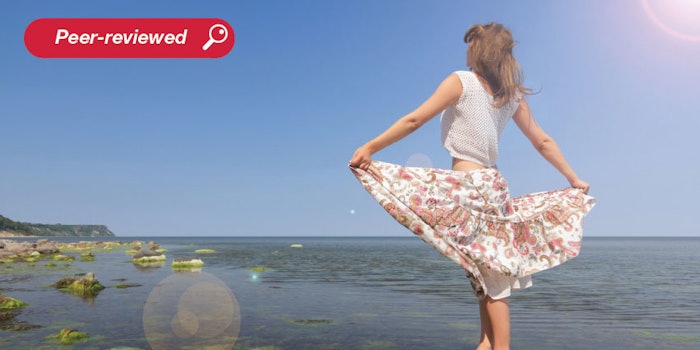
Read the full feature in the July/August 2022 digital edition here. . .
Skin aging can be accelerated by a variety of extrinsic factors including physical damage from the external environment. As is well-known, one of the major assaults on skin is promulgated by ultraviolet (UV) radiation emanating from the sun. UV light is a non-ionizing form of radiation that can be divided into three types based on their respective wavelength ranges: UV-A, UV-B and UV-C.
Each type inflicts damage to a varying degree on the DNA genetic code in the nuclei of skin cells—presenting in the form of mutations known as thymidine dimers or cyclopyrimidine dimers (CPDs) and 6,4-photoproducts (6,4-PPs). The cumulative damage incurred from this radiation is the driving force behind the phenomenon known as photoaging.
Skin cells are equipped with pathways to repair DNA damage. One such pathway, the nucleotide excision repair pathway (NER), targets the genomic damage incurred from exposure to UV light.1-3 This pathway is primarily responsible for the careful removal of so-called bulky adducts, CPDs and 6,4-PPs, which impede the progression of DNA replication and messenger ribonucleic acid (mRNA) transcription complexes along the DNA double helix.
The repair process follows four successive steps: 1) recognition of the genetic damage, usually by the presence of stalled transcription complex; 2) incision into the particular DNA strand possessing the damaged nucleotides; 3) the removal of the damaged portion of DNA; and 4) final repair by the synthesis of new DNA and its ligation into the strand to replace the excised portion. This repair mechanism has the capacity to replace oligonucleotide lengths of approximately 20-30 nucleotides.4, 5
In relation, the capability of a unique class of polyphenolic molecules known as phlorotannins (1,3,5-trihydroxybenzene) to resist and repair UV-induced DNA damage has been identified in brown algae. These polymers of the compound phloroglucinol (see Figure 1) are exclusive to marine seaweeds and have reported photoprotective effects, as they absorb UV light.6-8 Many species of brown algae have been explored and show a demonstrable correlation between phlorotannin content and the suppression of DNA damage.
Furthermore, there is evidence from other phlorotannin-containing brown algae species that UV exposure induces the cellular production of phlorotannin molecules. These compounds are usually found distributed along the periphery of cells, particularly concentrated in the cell wall, which suggests their presence may be offsetting the UV light irradiation these seaweeds experience from sunlight and its reflection off the water surface.
In the push to identify natural sources for ameliorative skin care and to align with interests in green chemistry and clean beauty, scientists have turned to marine materials with potential utility. The work described here focuses on the free-floating seaweed Sargassum vulgare, which as the name suggests inhabits the Sargasso Sea. Members of its genus have been reported to provide photoprotection as well as antioxidant, anti-inflammatory, antimicrobial, antihyaluronidase and anti-lipoxygenase activities.
The seaweed itself is sustainably harvested and fermented using a proprietary yeast strain, Saccharomyces cerevisiae. Thus, through this process, phlorotannin molecules are rendered bio-available in large quantities using a harmless organism routinely used for centuries in the production of food products and alcoholic beverages. The downstream ferment was then subjected to testing for skin benefits as described here in a cosmetic ingredient referred to as Sargassum vulgare fermenta.
. . .Read more in the July/August 2022 digital edition here. . .
References
- Mitchell, D.L. and Nairn, R.S. (1989). The biology of the (6-4) photoproduct. Photochem Photobiol 49 805-819.
- Mitchell, D.L., Zdzienicka, M.Z., van Zeeland, A.A. and Nairn, R.S. (1989). Intermediate (6-4) photoproduct repair in Chinese hamster V79 mutant V-H1 correlates with intermediate levels of DNA incision and repair replication. Mutat Res 226 43-47.
- Nairn, R.S., Mitchell, D.L., Adair, G.M., Thompson, L.H., Siciliano, M.J. and Humphrey, R.M. (1989). UV mutagenesis, cytotoxicity and split-dose recovery in a human-CHO cell hybrid having intermediate (6-4) photoproduct repair. Mutat Res 217 193-201.
- Kusakabe, M., Onishi, Y., ... Sugasawa, K., et al. (2019). Mechanism and regulation of DNA damage recognition in nucleotide excision repair. Genes Environ 41 2.
- Rouillon, C. and White, M.F. (2011). The evolution and mechanisms of nucleotide excision repair proteins. Res Microbiol 162 19-26.
- Catarino, M.D., Amarante, S.J., Mateus, N., Silva, A.M.S. and Cardoso, S.M. (2021). Brown algae phlorotannins: A marine alternative to break the oxidative stress, inflammation and cancer network. Foods 10.
- Erpel, F., Mateos, R., Perez-Jimenez, J. and Perez-Correa, J.R. (2020). Phlorotannins: From isolation and structural characterization, to the evaluation of their antidiabetic and anticancer potential. Food Res Int 137 109589.
- Kumar, L.R.G., Paul, P.T., ... Ravishankar, C.N., et al. (2022). Phlorotannins-bioactivity and extraction perspectives. J Appl Phycol 1-13.
a DermalRx FSE (INCI: Water (Aqua) (and) Sargassum Vulgare Extract (and) Saccharomyces Ferment Filtrate) is a product of BioCogent.











